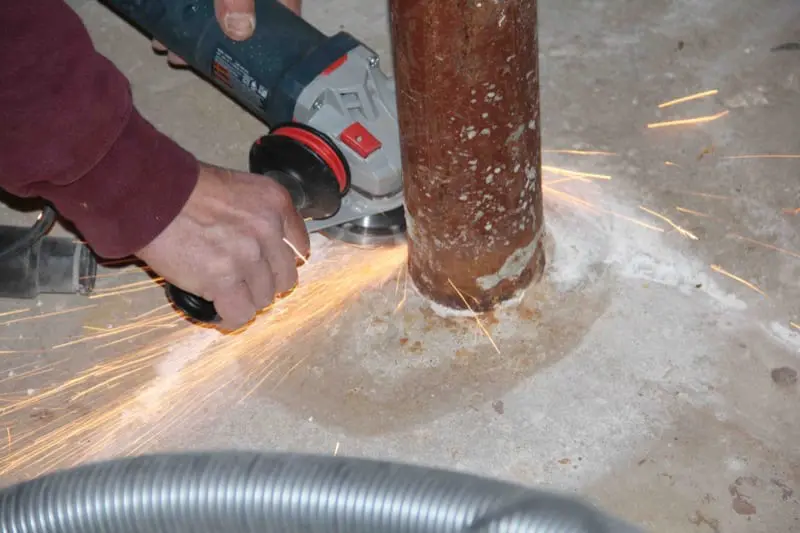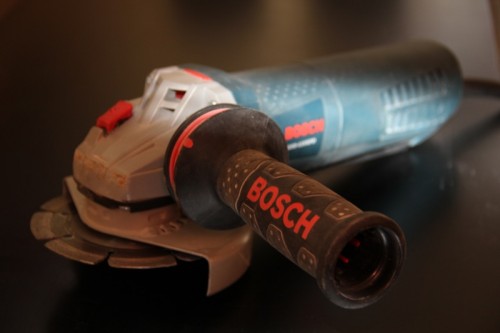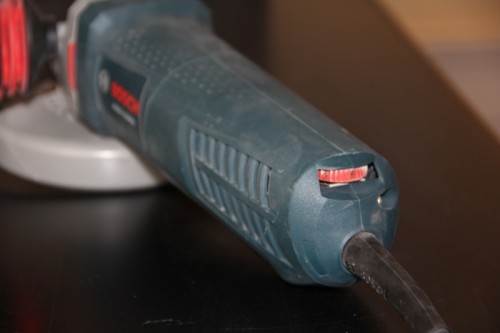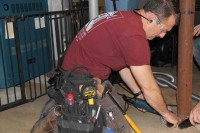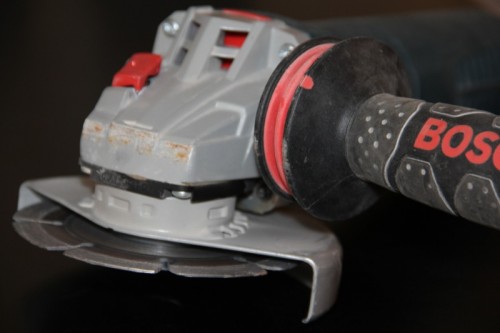As a carpenter I mainly find myself using grinders to occasionally cut through rebar or get structural bolts out of the way. It was by happy coincidence that, on the same week, I bid the Lally column job and the folks at Bosch allowed me to test their brand new Bosch AG50-11VSPD paddle switch grinder. (In fact, my sample was so early that it didn’t have the final retail labeling.) I couldn’t have asked for a better opportunity to evaluate a grinder, particularly since it’s not all that often I get to cut out steel cased, concrete filled columns.
I was recently asked to cut four old structural Lally columns out of a house and replace them with new columns. “Lally column” is a regional term, named after its inventor, John Lally, who ran a construction company from 1898-1907 in Waltham, MA (where I grew up). They are round, thin walled structural steel columns which are filled with concrete and oriented vertically to provide support to structural spans.The advantage of these columns over conventional structural steel is that they can be cut to length on a construction site with a simple plumber’s pipe cutter. Cutting them, flush to the ground or otherwise, is best accomplished with a grinder. Since Bosch has just worked over its full line of new corded grinders, this was the perfect opportunity to put at least one of them to the test.
Choosing Your Grinder
Bosch’s recent overhaul of their grinder line presents customers with eleven tools to choose from, including four slide switch grinders and seven paddle switch models. With this new line Bosch offers a number of different features to meet a variety of user needs. Their focus is to give the tradesman more control, more power and more tool life. Having used some of their former models, I was determined to find out if the new tools were a serious step up or just a minor tweak on some already good tools.
Bosch’s New Grinder Lineup
Slide Switch Grinders
- AG40-85: 4.5-inch angle grinder featuring an 8.5-amp, 11,500 rpm motor
- AG50-10: 5-inch angle grinder featuring a 10-amp, 11,500 rpm motor
- AG50-11VS: 5-inch variable speed grinder featuring an 11-amp, 2,800-11,500 rpm motor
- AG60-125: 6-inch high-performance cut-off/grinder featuring a 12.5-amp, 9,300 rpm motor
Paddle Switch Grinders
- AG40-85P: 4.5-inch angle grinder with paddle switch featuring an 8.5-amp, 11,500 rpm motor
- AG40-85PD: 4.5-inch angle grinder with no lock-on paddle switch featuring an 8.5-amp, 11,500 rpm motor
- AG40-11P: 4.5-inch high-performance angle grinder with paddle switch featuring an 11-amp, 11,500 rpm motor
- AG40-11PD: 4.5-inch high-performance angle grinder with no lock-on paddle switch featuring an 11-amp, 11,500 rpm motor
- AG50-11VSPD: 5-inch variable-speed angle grinder with no lock-on paddle switch featuring an 11-amp, 2,800-11,500 rpm motor (Tested)
- AG50-125PD: 5-inch high-performance angle grinder with no lock-on paddle switch featuring a 12.5-amp, 11,500 rpm motor
- AG60-125PD: 5-inch high-performance cut off/grinder with no lock-on paddle switch featuring a 12.5-amp, 9,300 rpm motor
First Impression
I chose the Bosch AG50-11VSPD paddle switch grinder for my testing after having tried it out at the 2013 World of Concrete convention in Las Vegas. The AG50-11VSPD is a 5-inch, 11 amp, variable speed grinder that weighs just 6.5 pounds. It spins at 11,500 rpm and would be a good match for the kind of work I do, including my present column cutting task.
Handing the tool, I really like the way the paddle handle switch feels and I truly believe that the no-lock on switch is the only way to go with grinders. To explain my preference I would have to say that I often use tools in weird positions and in confined spaces. The paddle switch offers the opportunity for multiple grip positions that lets me operate the tool at the front, middle and rear of the grinder housing depending on my body position or need for control.
These switches are also also nice because I can power on or off the tool from wherever my hand happens to be. My older grinder had a lock on switch where, once turned it on, I could move my hands around the body of the grinder, but I always had to go back to the switch to turn off the tool. In some scenarios that can be a more dangerous use of the tool (so it’s nice to be given the choice).
I also noticed that Bosch adjusted the venting so that it covers more surface area. This should help avoid having the operator’s hands block air flow and potentially overheat the grinder. The side handle looks to be unchanged and continues to have a flexible, almost shock absorbing feature to it.
And that’s where the small stuff gives way to the big stuff, because Bosch’s new grinders now boast about 2 amps more power than the previous generation. And you can feel it. Cutting through steel and concrete is a great way to test out any tool and the power of this grinder is impressive for its size. Bosch is also still using the Service Minder brushes that, in additional to claiming longer life, stop the tool when it’s time for maintenance. While that’s business as usual, a new feature Bosch calls “Electronics System Plus” has been added (or at least called out) which is an electronic package designed to better protect the motor and shut down the tool in the event that it suddenly binds up. I actually tested that out on more than one occasion. It works.
Let the Sparks Fly!
I used a Bosch DB4564 4.5-inch segmented diamond blade on the AG50-11VSPD grinder, and it cut amazingly clean and fast. Of course, it also made lots of sparks—and who doesn’t like that! While cutting out four of these columns I observed several of the safety features. The first feature is that the grinder has a “soft start.” The tool fired up to max speed and was able to maintain full rpms during the entire cut. I literally beat the pants off this grinder trying to get it to bog down. The only time I noticed any effect on my grinding was when the grinders’ electronic clutch engaged. The electronic clutch is a built-in safety feature designed to shut the motor down to prevent a bind situation. In this particular case the wheel became pinched, and the clutch worked perfectly—protecting both me and the tool.
The second feature I liked was a holdover from their current models—the flexible side handle. Like most grinders, the handle can be positioned on either side of the tool, but this handle has a flex design built right into it. It really reduces vibration from the tool, and it makes repetitive work a lot more comfortable.

